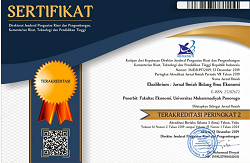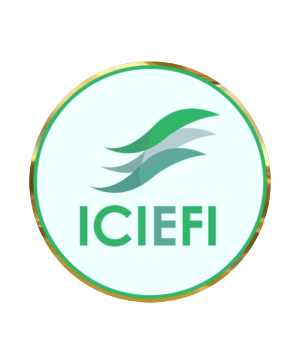Money Demand Analysis through Business Cycle in Indonesia
DOI: 10.24269/ekuilibrium.v18i2.2023.pp203-212
Abstract
There is still debate about the role of monetary aggregates (money demand) and their nature in the domestic economy, whether there is a direct affect and indirect affect. After the 2008 crisis, monetary aggregates became a monetary policy tool that played an important role in maintaining domestic economic stability. This study aims to examine macroeconomic variables on the demand for money in Indonesia from 2000Q1-2021Q4 using the VECM approach. The business cycle is used as a proxy for the income variable with the Hodrick-Prescott Filter method on the GDP variable. The results show that income has a high degree of variability in the demand for money and there is a sensitivity in the response of the demand for money to fluctuations in domestic interest rates. The implication of this research the application of domestic interest rates at the lowest level can encourage income which can increase the demand for money in Indonesia.
Keywords
References
- Abdillah, K. (2023). Optimum Government Size and Economic Growth in Indonesia: ARDL Model Approach. Ekuilibrium : Jurnal Ilmiah Bidang Ilmu Ekonomi, 18(1), 37–47. https://doi.org/10.24269/ekuilibrium.v18i1.2023.pp37-47
- Abdulkheir, A. Y. (2013). An Analytical Study of the Demand for Money in Saudi Arabia. International Journal of Economics and Finance, 5(4), 31–38. https://doi.org/10.5539/ijef.v5n4p31
- Bahmani-Oskooee, M., & Baek, J. (2016). Economic uncertainty, monetary uncertainty and the Korean demand for money. Journal of Economic Policy Reform, 20(1), 86–97.
- Bahmani-Oskooee, M., & Nayerim, M. M. (2018). Policy uncertainty and the demand for money in Australia: An asymmetry analysis. Australian Economic Papers, 57(4), 456–469.
- Basuki, A. T., & Yuliadi, I. (2015). Ekonometrika Teori dan Aplikasi.
- Duca, J. V, & VanHoose, D. D. (2004). Recent developments in understanding the demand for money. Journal of Economics and Business, 56(4), 247–272.
- Folarin, O. E., & Asongu, S. A. (2019). Financial liberalization and long-run stability of money demand in Nigeria. Journal of Policy Modelling, 41(5), 963–980.
- Freeman, S., & Huffman, G. W. (1991). Inside Money, Output, And Causality. International Economic Review, 32(3), 645–667.
- Friedman, L. . M. (1975). The Legas System a Social Science Perspective.
- Friedman, M., & Schwartz, A. J. (1963). Money and Business Cycles. The Review of Economics and Statistics, 45(1), 32–64.
- Goyal, A., & Kumar, A. (2018a). Money and business cycle: Evidence from India. The Journal of Economic Asymmetries, 18, 1–14.
- Goyal, A., & Kumar, A. (2018b). Money and business cycle: Evidence from India. Journal of Economic Asymmetries, 18(June), e00105. https://doi.org/10.1016/j.jeca.2018.e00105
- Hodrick, R., Kocherlakota, N., & Lucas, D. (1991). The variability of velocity in cash-in-advance models. Journal of Political Economy, 99(2), 358–384.
- James, G. A. (2005). Money demand and financial liberalization in Indonesia. Journal of Asian Economics, 16(5), 817–829. https://doi.org/10.1016/j.asieco.2005.08.003
- Kurniawan, M. L. A. (2020). The stability of money demand in Indonesia: An ARDL approach. Optimum: Jurnal Ekonomi Dan Pembangunan, 10(2), 153–162.
- Kurniawan, M. L. A., A’yun, I. Q., & Perwithosuci, W. (2022). Money Demand in Indonesia: Does Economic Uncertainty Matter? Jurnal Ekonomi & Studi Pembangunan, 23(2), 231–244. https://doi.org/10.18196/jesp.v23i2.15876
- Narayan, P. K. (2007). Is money targeting an option for Bank Indonesia? Journal of Asian Economics, 18(5), 726–738. https://doi.org/10.1016/j.asieco.2007.06.002
- Nelson, E. (2003). The future of monetary aggregates in monetary policy analysis. Journal of Monetary Economics, 50(5), 1029–1059. https://doi.org/10.1016/S0304-3932(03)00063-1
- Pesaran, M. H., Shin, Y., & Smith, R. J. (2001). Bounds testing approaches to the analysis of level relationships. Journal of Applied Econometrics, 16(3), 289–326. https://doi.org/10.1002/jae.616
- Poole, W. (1970). Optimal choice of monetary policy instruments in a simple stochastic macro model. The Quarterly Journal of Economics, 84(2), 192–216.
- Prawoto, N. (2000). Permintaan uang di Indonesia: Konsep Keynesian dengan pendekatan PAM. Jurnal Ekonomi & Studi Pembangunan, 1(1), 1–13.
- Rao, B. B., & Kumar, S. (2009). A panel data approach to the demand for money and the effects of financial reforms in the Asian countries. Economic Modelling, 26(5), 1012–1017.
- Rogoff, K. (2017). Monetary policy in a low interest rate world. Journal of Policy Modeling, 39(4), 673–679.
- Setiadi, I. O. (2013). Analisis faktor-faktor yang mempengaruhi permintaan uang di Indonesia tahun 1991:Q1-2010:Q4 dengan pendekatan error correction models (ECM). Jurnal Ekonomi Pembangunan, 2(1), 1–9.
- Sujianto, A. E., & Azmi, M. F. U. (2020). Associative Study on Government Spending, Inflation, Trade Balance, and Gross Domestic Product. Ekuilibrium : Jurnal Ilmiah Bidang Ilmu Ekonomi, 15(1), 27. https://doi.org/10.24269/ekuilibrium.v15i1.2363
- Susilo, J. H., Tsani, L. I., Herianto, H., & Kholilurrohman, M. (2020). Econometrics Model of Economic Growth in East Java Province with Dynamic Panel Data through Generalized Method of Moment (GMM) Approach. Ekuilibrium : Jurnal Ilmiah Bidang Ilmu Ekonomi, 15(1), 38. https://doi.org/10.24269/ekuilibrium.v15i1.2372
- Šustek, R. (2010). Monetary aggregates and the business cycle. Journal of Monetary Economics, 57(4), 451–465. https://doi.org/10.1016/j.jmoneco.2010.03.003
- Telyukova, I. A., & Visschers, L. (2013). Precautionary money demand in a business-cycle model. Journal of Monetary Economics, 60(8), 900–916. https://doi.org/10.1016/j.jmoneco.2013.08.006
- Widodo, A. (2015). Faktor-faktor makroekonomi yang mempengaruhi permintaan uang di Indonesia. Jurnal Ekonomi Dan Studi Pembangunan, 16(1), 63–72.
- Woodford, M. (2001). The Taylor rule and optimal monetary policy. The American Economic Review, 91(2), 295. https://doi.org/10.2307/136324
Refbacks
- There are currently no refbacks.

This work is licensed under a Creative Commons Attribution-ShareAlike 4.0 International License.














